|
Elliot Felix 6 December 2004  Download PDF version Download PDF version
|
|
Elliot Felix 6 December 2004  Download PDF version Download PDF version
|
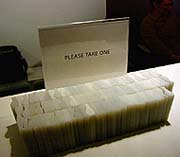 Cacht 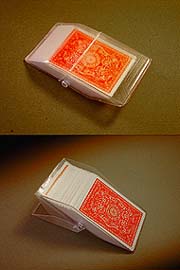 Cardcase 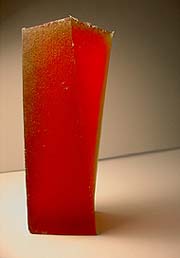 torqued 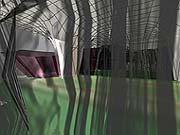 Pattern/Decoration Structured Incongruity 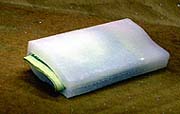 Cacht |
Project Description Cacht is a temporary installation of serially-produced symbolic objects conceived to call attention to the museum donation process. Upon entering the gallery, visitors are offered a tangibly compelling object with a unique shape and a translucency that alludes to its contents: currency of variable denominations. While experiencing the exhibit, the visitor forms a relationship with the object. Then, at the exit, the visitor may notice a slot in the donation box that corresponds to the object's shape or may see other identical objects deposited within the box. Such observations then offer the visitor a choice as to whether to keep the object, its contents, or both.
One of the most interesting aspects of the Cacht project is that while it was conceived as part of a collaborative effort, it still remained personal to each member in our group—that is to say, we each had different ideas going into it, we each had dissimilar motivations behind what was collectively agreed upon, and we each find our own meanings in it. For my part, the project relates in two major ways to ideas or issues that I have been thinking about and investigating, at least indirectly, in all my creative work at the moment: (1) the relationship between form and embedded meaning and (2) generative/intuitive creative processes. One of the main goals for Cacht was using form to communicate meaning to the greatest extent possible. Since one of my preoccupations at the moment is the relationship between form and embedded meaning, this was of particular interest to me. In an extended paper I have nearly completed, I move from symbols to buildings and cities to posit that the meaning we attach to form is nearly entirely situated within the cultural context in which the symbol/object/building/city/etc is perceived. Though this idea makes sense in general, it does belie a great deal of what I used to think about form, and so I've spent a lot of time pushing on it to try and find the boundaries between where form is or is not inherently meaningful. I have explored these boundaries in all of my work of late. In my studio work, this investigation played out primarily in understanding the perception of order as opposed to the perception of meaning, and I did a number of readings (Gombrich's A Sense of Order, for example) as well as a speculative project on for example) as well as a speculative project on pattern and decoration to get at this issue. In my industrial design class, one of the first projects I did, a case for playing cards, involved a simple case that could be unfolded to serve as a dealing aid but this unfolding was not readily evident in the form and thus required a large cognitive leap to fully use the case. As such, in a subsequent project for a physical therapy device or stress reliever which one twisted for exercise/relaxation, I tried to embed the object's instructions for use into its form by employing a torqued form that does indeed encourage a user to twist it. And so, within this context, the Cacht project is a further exploration into how an object's form might suggest its use or purpose, and therefore we tried to use the communicative potential of the object's unique profile by creating a correspondence between it and the donation slot within the gallery to serve as the project's only overt explanation or instructions. Whether these instructions prove to be sufficient remains to be seen, but either way, the project is an interesting exploration into how much can be communicated with form itself—somehow this seems a worthy goal and everyone in the group seemed to think that any additional text within the project would have been akin to voice-over in film wherein a filmmaker is forced to say what he/she cannot show. The second major area of personal interest within the project proved to be its unscripted (LVAC Curator Bill Arning's terminology) nature. My creative work this semester has had a lot to do with exploring intuitive, generative design strategies—his in contrast to the intention-based (perhaps deterministic) strategies which previously served as my primary creative methodology. The basic premise of such a philosophy or strategy is that by engaging in open-ended, exploratory processes whose ends cannot be foreseen, there is an added potential for richness, sophistication, uniqueness, poignancy, and so on—a bit akin to the idea that one might discover more interesting places in a city by wandering through it rather than charting specific courses from maps, guides, etc... I have been principally employing these generative strategies in the design studio with mixed results, having now realized that such processes don't involve delegating agency or creative control to a process (or a computer) but rather, shift the designer's agency until the middle or end of a process such that he/she is positioned to modify, reinforce, redirect, or abandon such processes according to various criteria. In retrospect, I can now see that many such generative processes are at work in Cacht, and all seemed to have had positive results. First, the profile of the object Cacht was determined through a transformation and subsequent tessellation of George Washington's eye profile from the one dollar bill and as a result of this exercise, we arrived at a unique shape that we might not have come up with had such a process not been set in motion. Second, in order to produce subtly unique but "identical" objects, we used a casting process that used identical, 3dprinted negatives knowing that the pouring and casting process would create relatively uncontrollable variation between objects through the conditioning/erosion of the mold, mixing differences between batches, and through the protracted post-production processes of cutting, trimming, washing, and dollar-stuffing. Lastly and most importantly, because the use and ultimate fate of the objects is not determined but rather is unscripted, the project as a whole is enriched. That is, because a visitor can keep both the currency and the object, keep one or the other, keep neither, or any other possibility, the ambiguous meaning of Cacht gives it more potential and more interest than if we determined the exact purpose, circulation path/method, and ultimate destiny for the project at its outset. The unscripted nature of the project and the generative nature of these processes, coupled with the investigation of the ability to embed meaning/significance/communication within a form provided the main areas of personal interest within the project and its process of conception as well as fabrication. These two concerns also position the project in an interesting dialog with some of my other work and ultimately they will inform each other—at least that is my hope. << back |